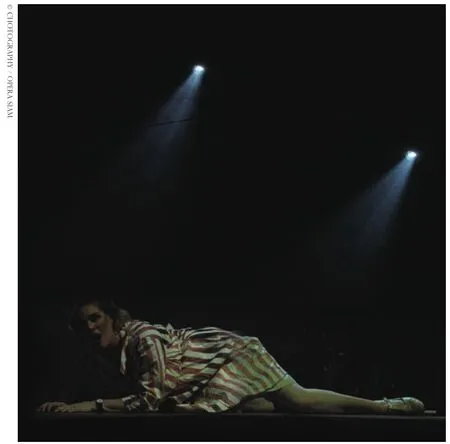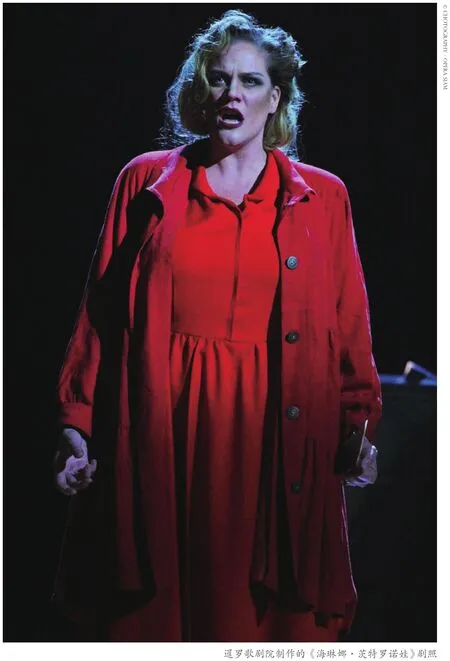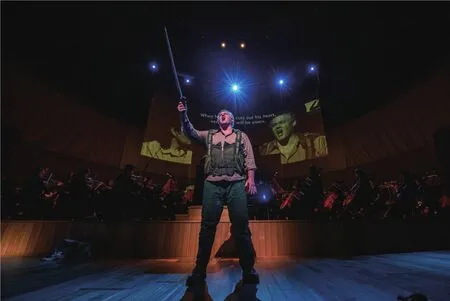业余时光:非职业乐团在新加坡与曼谷的成功表现
2020-02-29司马勤KenSmith编译李正欣
文:司马勤(Ken Smith) 编译:李正欣
几个月前,我在这个专栏里谈及了两种乐团:交响乐团和坐在乐池中的乐团。当时的逻辑显得很合理,但后来我发现了几个漏洞。
我所指的,跟卡内基音乐厅前任艺术策划总监杰里米·格芬(Jeremy Geffen)有一次告诉我的漏洞不一样。他曾告诉我,自己遵循所有的犹太教规中的饮食规则,“培根除外”。那不是个小“漏洞”,简直就是模式上的转变。而我所指的漏洞是一个更简单的例子,即强调某些概括性或模糊不清的界定因素,故意避开其他的关键要点。
维吉尔·汤姆森(Virgil Thomson)是最先提出“两种乐团”概念的人,他最喜欢在遣词造句方面一概而论,目的是故意挑战某些读者,引起他们的反感。他这样做也是经过深思熟虑的:他所归纳的两个门类——“庞大的乐团和直接功能性的乐团”之中,将非职业与学生乐团放在了第二类的最低层次中。
自我从有记忆以来,朋友圈里有不少非职业的音乐家与学生音乐家。要是他们知悉汤姆森的见解,我能猜得到他们的反应——也就是,反感——因此,我故意完全回避了这个话题。不过,上个月我遇上一些非职业音乐家和学生音乐团体。说真的,我要为他们平反,让他们可以走出“最低层次”的境地。
***
1月初,我人在新加坡,观看当地制作的《女武神》首演——这不仅是新加坡罕有的瓦格纳制作,也很有可能为东南亚地区首套全舞台版制作的《指环》打响头炮。让我在这里正式声明,这并不是新加坡歌剧团(Singapore Lyric Opera)出品,也不是新加坡交响乐团(Singapore Symphony Orchestra)的制作。把《女武神》搬上舞台的,是一群非职业的音乐家,他们组织了自己经营的创乐者交响乐团(Orchestra of Music Makers)。
我们再进一步探讨:西方歌剧经典中最具挑战性的作品之一在新加坡上演,而把这部作品付诸实践却是一群由医生、律师与商人组成的团队。创乐者交响乐团成立于2008年,当时,一群钟爱音乐的中学生遵从父母的意愿,填报了 “真材实料”的大学专业志愿,毕业后在社会上也纷纷找到“实在的工作岗位”,但他们十分坚决地不放弃音乐。

新加坡创乐者交响乐团制作的《女武神》剧照(摄影:许智勇)
起初,他们甚至不确定自己是否想要举办公开演出,可是这些疑虑很快就被打消了。你可以想象,拿到商科与法律学位的人,在求学时期就已经被灌输了大量的自信,在管理技能方面同样熟练有加。过了不久,创乐者交响乐团(他们找来了科班出身的专业指挥,还有一位职业乐手当乐团首席)开始在新加坡最显赫的表演场地——滨海艺术中心,举行定期音乐会。乐团于2011年录制了马勒《第二交响曲(复活)》,音频被纳入新加坡航空公司的机上娱乐系统,更赢得英国《留声机》(Gramophone
)杂志的赞许。一年后的夏天,乐团获邀于英国切尔滕纳姆(Cheltenham)与利奇菲尔德(Lichfield )音乐节亮相。然后是2015年,乐团搬演了马勒《第八交响曲》——声名远播的“千人交响曲”(虽然舞台上大约只有350人)。两年后,乐团搬演了英格伯特·洪佩尔丁克(Englebert Humperdinck)的《汉泽尔与格蕾泰尔》(Hansel and Gretel
)半舞台版制作。到了2018年,搬演了伦纳德·伯恩斯坦(Leonard Bernstein)的《弥撒》(Mass
)。这种无所畏惧的精神赢得当地媒体激赏,与乐季编排平平无奇的新加坡交响乐团(尤其是领导该团多年的音乐总监水蓝去年卸任后相比),形成很大的反差。我们回顾一下此次创乐者乐团制作的瓦格纳庞大乐队编制的《女武神》以及近30万欧元的制作费用吧。这个制作不算“彻底”的本土化——只有两位演员(饰演九名女武神中的成员)来自新加坡,其他演员从美国、英国与澳大利亚远道而来——但导演与制作团队都来自新加坡,皆为当地戏剧界的中坚人物。
在导演伊蒂丝·普德斯塔(Edith Podesta)的构思里,乐团坐在舞台中央,穿上戏服的演员则位于乐团前下方(升高了的乐池区)以及乐团后上方(舞台后建造了代表瓦尔哈拉的山峰,演员得经常上上下下)。大型的投影除提供英语字幕之外,更展示出一些由瓦格纳的主导动机(leitmotif)所衍生出的视觉设计,也有现场演出的即时视像特写(让大家看得清演员的面部表情)。于是,多层次的细腻感情与瓦格纳庞大的音乐编制相得益彰,特别是当演员们分隔在舞台两边的时候。
所有这些设计让我们意识到这个制作实际上是围绕着乐团展开的。创乐者交响乐团在陈子乐——他是乐团创办人之一,同时担任音乐总监——指挥下,这群非职业乐手大致上成功地应对了这次挑战。弦乐像是一堵精亮的音墙,听起来统一、准确、辽阔。个别木管与铜管乐手也许不习惯从乐队中突显出来——也可能是耐力不够——所以偶尔的出现了错失。最重要的是,陈子乐对于瓦格纳风格把握得很好,乐手们坚定而顽强地奏完等同于两套交响乐音乐会时长的曲目。总的来说,这场演出与众多欧洲歌剧院的水平不相上下。
***
下一站是曼谷。在那里,我遇上一群学生。2001年,曼谷歌剧院(Bangkok Opera)(后来改名暹罗歌剧院,Opera Siam)由桑姆托·苏恰里故(Somtow Sucharitkul)创办。这位泰国出生但在英国接受过教育的作家与作曲家,创办歌剧院的初衷,跟新加坡创乐者交响乐团开头一样,都是小型院团。可是歌剧院的艺术宗旨随着创办人善变的思维而有所变动。暹罗歌剧院也是东南亚首家开拓《指环》制作的表演团体,虽然至今已两度推迟《齐格弗里德》的制作。在过去几年里,歌剧院制作了自己出品的史诗式歌剧:桑姆托撰写的《佛陀本生十世》(Ten Lives of the Buddha
),至今已经演了六部。
新加坡创乐者交响乐团制作的《女武神》剧照(摄影:许智勇)
今年1月中旬,桑姆托的最新歌剧作品《海琳娜·茨特罗诺娃》(Helena Citrónová
)抢先公演,歌剧《佛陀》的第七部也因而被推迟。从各个层次来看,《海琳娜》代表了崭新的出发点。剧本根据真人真事改编,描述了被困在奥斯威辛集中营的犹太女子与一名纳粹侍卫坠入爱河的故事,剧情发展所利用的音乐混合了无调性旋律及当时的流行音乐曲风,乐团衬托的音乐令人联想起伯纳德·赫尔曼(Bernard Herrmann)的管弦乐配器;台上更设有犹太克莱兹默(klezmer)小乐队,在适当的时候加入演奏,让我们在跟随故事的发展的同时,时不时还能耳目一新。就像创乐者交响乐团的模式,暹罗歌剧院只聘用了几位本地歌唱家担任配角,其他主演来自世界各地。整场演出的情感迂回路转,故事的两位主角——美国女高音卡桑德拉·布莱克(Cassandra Black)饰演海琳娜、德国男中音法尔克·赫尼茨(Falko Hönisch)饰演纳粹侍卫法兰茨·弗恩舒(Franz Wunsch)——合演多段二重唱,有时候富有戏剧张力,有时候抒情至极。这部歌剧的原动力来自乐池中的管弦乐团。指挥特里斯蒂·纳·帕塔楞(Trisdee na Patalung)融汇了总谱中包含的多种风格,把它们糅合成为一体,负责演奏的暹罗小交响乐团(Siam Sinfonietta)在帕塔楞的引领下,充满激情,信心坚定。演出结束后,我才知道暹罗小交响乐团的团员年龄从12岁到25岁不等,乐团中有几位年轻的职业乐手,由他们带领着曼谷各中学的学生乐手一起演奏。

上、左页:暹罗歌剧院制作的《海琳娜·茨特罗诺娃》 剧照
不知何故,我听闻这个消息后,并不感到惊讶。新加坡创乐者交响乐团对所谓“业余”(amateur)的界定,其实是根据这个英文词汇的拉丁词根:他们爱好音乐,所以弹奏音乐。很多不依靠音乐赚钱的音乐家宁愿用“非职业”(avocational)这个词语,因为“业余”隐喻着马虎与非内行的贬义。在我印象中最难忘的演出,有不少是名副其实“爱好者”的演出,而不是那些按时钟计算薪水的音乐家。反过来,我经历过不少“职业乐手”无精打采的音乐会:他们排练充分,演奏出来的表面音色十全十美,可是内心的激情火花完全熄灭了。有一次,在听过一场死气沉沉的音乐会后,我描述那场演出是“音乐停尸间”:那里的音乐已经“死去”了,可它比还“活着”的时候更悦耳。
创乐者交响乐团可以为观众献上专业水准的演出,是因为1.从他们的角度来看,判断演出的成功与否的根据,是演奏的效果,而不是薪酬多少;2.每年只演几场音乐会,可以为每一场音乐会的曲目投入更多的时间。同样地,暹罗小交响乐团的学生们可能永远都达不到职业乐团那种打磨得非常光滑的音效,但年轻人带来的,是刚刚发现音乐美妙之处时那毫无保留的兴奋和纯粹。我可以保证,很多腻烦的职业音乐家一看到桑姆托的乐谱就会贬低这部歌剧,因为首先它是新作品,其次它不是瓦格纳作品。
完全漠视职业音乐家当然也不公平。科班出身的职业音乐家不但能展示卓越的演奏技艺,而且无论演出多少场次还能确保同样的高水平。创乐者交响乐团此番只安排了一场《女武神》演出,倘若他们加演第二场——或者暹罗歌剧院连续三晚搬演《海琳娜·茨特罗诺娃》——乐团团员由肾上腺素激发的动力,能与首场演出时保持一致吗?大概不行。因为我观看的都是首演场次,所以我真的不在乎。

上、左页:暹罗歌剧院制作的《海琳娜·茨特罗诺娃》 剧照
A couple of months ago I wrote that there were two types of orchestras: symphonic ensembles and pit bands.It made sense at the time, but since then I’ve found a couple of loopholes.
I don’t mean a loophole like Jeremy Geffen, the former Carnegie Hall director of artistic planning,telling me he follows all the Jewish dietary rules“except for bacon.” That’s more of a paradigm shift.This is a simple case of choosing different generalizations and ambiguities to emphasize.
Virgil Thomson, who started the whole “two types of orchestras” thing, loved sweeping generalizations, mostly because they annoy all the right people.But he didn’t do it recklessly: His own two orchestral categories—“the monumental and the directly functional”—included amateur and student groups as the bottom rung of the second.
Having been around amateur and student musicians my whole conscious life, I knew just how well they would respond to that—i.e., not favorably—so I avoided the subject altogether.After last month, though, I’m back to amateurs and students.In fact, I’m arguing for their promotion.
***
In early January, I was in Singapore for the local premiere ofDie Walküre
—not just a rare Wagner production in the region but actually the launch of what might well end up as the first completed Ring Cycle in Southeast Asia.And let the record state, this was not produced by the Singapore Lyric Opera, or even the Singapore Symphony Orchestra, but rather a group of amateur musicians called the Orchestra of Music Makers.Let’s look at this again: the most challenging corner in the Western operatic canon appeared in Singapore through the efforts of a group of doctors,attorneys and businessmen.OMM first began playing together in 2008 when a group of secondary school music students essentially agreed to their parents’ demands to “get real jobs,” but still refused to give up music.
At first, they weren’t even sure they wanted to play in public, but those doubts ended quickly.Business and law degrees usually instill a certain amount of self-assurance, as well as a few administrative skills,and soon OMM (with a grown-up conductor and a professional concertmaster) was playing regularly at the Esplanade, Singapore’s preeminent performing arts center.The orchestra’s 2011 recording of Mahler’s “Resurrection” Symphony, featured on Singapore Airlines’ in-flight playlist and favourably reviewed in England’sGramophone
magazine,resulted in invitations to the Cheltenham and Lichfield music festivals the following year.Then there was their 2015 performance of Mahler’s Eighth—the famous “Symphony of a Thousand” (albeit with only about 350 on stage)—then two years later, a semi-staged production of Humperdinck’s operaHansel and Gretel
, then a 2018 staging of Leonard Bernstein’sMass
.Such fearlessness has been heavily lauded in the local press, in contrast with the lack of interesting programming coming from the Singapore Symphony Orchestra ever since their longtime music director Lan Shui stepped down a year ago.But back toWalküre
, with its full Wagnerian orchestra and nearly €300,000 production budget.This was not anentirely
local effort—only two cast members, both playing Valkyries, were from Singapore, the rest of the singers coming from the US, UK and Australia—but the director and production team were all recruited from Singapore’s active theatre community.Director Edith Podesta’s conception kept the orchestra center stage, while a fully costumed cast moved both in front and below (occupying what would usually be the orchestra pit) and behind and above (scaling a makeshift mountain to represent Valhalla at the rear of the stage).Large-scale projections offered not only English translations but also recurring visualisations of Wagner’s leitmotifs and frequent close-ups of the singers, bringing layers of emotional intimacy to the score’s epic scope, particularly when the singers themselves were placed on opposite sides of the stage.
All of this meant that the story literally revolved around the orchestra, and with OMM music director and co-founder Chan Tze Law on the podium the amateurs mostly rose to the occasion.String playing was a polished sonic wall, uniformly precise and expansive, a few occasional cracks coming from individual wind and brass players not used to the exposure—or, perhaps the endurance—required.Above all, Chan commanded a sure sense of idiom, the musicians powering through the equivalent of two backto-back symphonic programs.And ultimately, the evening was indistinguishable from many provincial European opera houses.
***

Siegfried
twice.In the meantime, they’ve launched their own homegrown epic, namely Somtow’sTen Lives of the Buddha
, which is currently up to episode six.
新加坡创乐者交响乐团制作的《女武神》剧照(摄影:许智勇)
Buddha, too, got pre-empted in mid-January by Somtow’s latest opera,Helena Citrónová
, which was a departure on every level.The libretto,inspired by a true story of a Jewish prisoner in Auschwitz and her relationship with a Nazi guard,unfolded in an eclectic mix of atonal musical themes and epochal popular tunes, all held together by a Bernard Herrmann-like orchestral backdrop with an onstage klezmer band to cleanse the aural palate as needed.Like OMM’sWalküre
,Opera Siam’s Helena had a handful of local singers in secondary roles amidst a largely international cast.Emotionally, the evening took its cues directly from the American soprano Cassandra Black (as Helena) and German baritone Falko Hönisch (as the Nazi guard), in a series of duets that ranged from dramatic to lyrical.The musical momentum, though, came from the orchestra pit, where conductor Trisdee na Patalung fused the score’s diverse musical influences into a seamless whole, coaxing passionate commitment from the Siam Sinfonietta.Only later did I find out that the players ranged in age from 12 to 25, a few young professional musicians helming students from Bangkok’s secondary schools.
Somehow, though, I was not surprised.OMM was“amateur” only in the original Latin roots of the word,doing things for the love of it.Many non-professionals call themselves “avocational” to avoid the taint of their sloppier, inexpert colleagues.And yet, some of the most memorable performances I’ve attended have hailed from trueamateurs
rather mercenaries playing music with one eye on the clock.Conversely,some of the most lifeless performances I’ve ever encountered have been by “professionals,” rehearsed to the point of surface perfection with the inner spark completely extinguished.I once compared a particular lifeless performance to a musical mortuary where the music was dead but sounded better than it did when it was alive.The OMM can deliver a professional quality product specifically because (a) they’re more invested in the musical results than the paycheck,and (b) they play fewer concerts and can devote more time to each one.Likewise, student groups like the Siam Sinfonietta will never achieve a professional’s sonic polish, but they bring to the table the sheer excitement of discovering something for the first time.I could list plenty of jaded professionals who would’ve discounted Somtow’s score simply because (a) it was new, and (b) it wasn’t Wagner.
Let’s not disregard the professionals entirely.The true mark of grown-up playing is not simply high quality, but rather delivering it consistently night after night.OMM presented only one performance.Would a secondWalküre
—or the third night of Opera Siam’sHelena Citrónová
—be as adrenaline-fueled as the first? Probably not.But since I was there for both on opening night, I really don’t care.